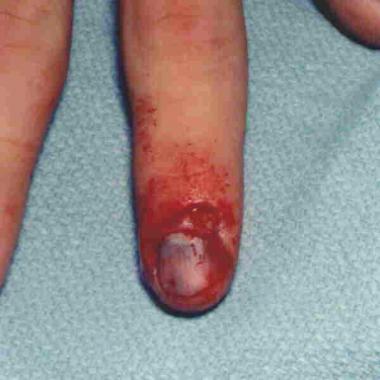

The fingertip is the part of the terminal phalanx that is distal to the insertion of extensor and flexor tendons. Fingertip injuries are extremely common. A functioning fingertip has sensation without pain, stable padding, and an acceptable appearance.
NextFingertip injuries occur frequently because hands are used to explore surroundings. Common types of injuries include blunt or crush injuries to the fingernail creating subungual hematomas, nail root avulsions, and fractures of the terminal phalanx. Sharp or shearing injuries from knives and glass result in lacerations and avulsion types of soft tissue defects. Burns and frostbite commonly involve fingertips.
See the image below.
 Significant nailbed injuries can occur from nail root avulsions.
Significant nailbed injuries can occur from nail root avulsions. United States
About 10% of all accidents encountered in the ED involve the hand. Hand injuries represent 11-14% of on-the-job injuries and 6% of compensation paid injuries. They account for approximately two thirds of hand injuries in children. Damage to the nail bed is reported to occur in 15-24% of fingertip injuries.[1]
Clinical Presentation
Copyright © www.orthopaedics.win Bone Health All Rights Reserved